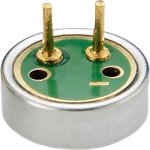Il est essentiel de comprendre les différentes classifications et caractéristiques des microphones. Depuis sa création, l'ECMIC se concentre sur la recherche et la fabrication de composants électroacoustiques, tels que des microphones, des buzzers et des haut-parleurs. Ces produits sont largement utilisés dans le divertissement audio, les appareils IoT, les appareils mobiles, la technologie automobile, les maisons intelligentes, etc.
Aujourd'hui, nous allons explorer les différences entre les microphones omnidirectionnels et unidirectionnels.

Définition des microphones
Un microphone, également appelé micro ou micro, est un dispositif de transduction sonore et électrique. Il sert de borne d'entrée aux appareils audio, convertissant le son en signal électrique, tandis qu'un haut-parleur fait l'inverse.
Classification des microphones
Les microphones peuvent être classés en fonction de leurs principes de fonctionnement en différents types : à grains de carbone, électromagnétiques, capacitifs, à condensateur électret (spécialité d'ECMIC), à cristal piézoélectrique, en céramique piézoélectrique et en dioxyde de silicium. Ils peuvent également être classés par taille en différentes séries telles que Φ9,7, Φ6, Φ4,5, Φ4 et Φ3, chacune avec des hauteurs différentes.
De plus, les microphones peuvent être classés par motifs directionnels en types omnidirectionnels, unidirectionnels et bidirectionnels (suppression du bruit), par polarisation en types diaphragme, électret arrière et électret avant, et par méthode de connexion en soudure régulière (type L), à pied PIN (type P) et cercle concentrique (type S).



Introduction aux microphones omnidirectionnels et unidirectionnels
Les microphones omnidirectionnels ont une sensibilité égale aux sons provenant de toutes les directions, fonctionnant selon le principe de la sensibilité à la pression. Ils sont couramment utilisés dans les situations nécessitant une capture du son ambiant, des sources sonores mobiles ou des présentations. Cependant, ils sont sensibles au bruit ambiant.
Les microphones unidirectionnels fonctionnent selon le principe du gradient de pression, recevant la pression de l'avant et de l'arrière à travers de petits trous dans la chambre du microphone, ce qui entraîne une sensibilité directionnelle et un effet de proximité.
Différence entre les microphones omnidirectionnels et unidirectionnels
Microphones unidirectionnels
- Petit rayon de captation (environ 30 cm), idéal pour une utilisation par une seule personne près de la bouche pour rejeter les sons lointains.
- Couramment utilisés comme micros col de cygne, qui se concentrent sur la capture du son provenant d'une seule direction.
- Plage de sensibilité limitée pour éviter les problèmes de rétroaction.

Microphones omnidirectionnels
- Grand rayon de captation (un à plusieurs mètres), adapté à la capture de plusieurs voix.
- Haute sensibilité, susceptible de capter le bruit ambiant, nécessitant des mesures de réduction du bruit pour une meilleure qualité audio.
- Avantageux pour les configurations de câblage simples, adapté aux petites réunions, aux conférences temporaires et aux discussions à distance.
- En règle générale, ils ne prennent pas en charge l'amplification locale en raison d'une sensibilité élevée, ce qui peut entraîner des problèmes de rétroaction.
ECMIC est à la pointe de l'innovation dans le secteur de l'électroacoustique. Notre engagement envers la technologie de pointe et nos investissements continus dans la recherche et le développement ont fait de nous un pôle d'attraction pour les meilleurs talents du domaine. Avec des installations de production à la pointe de la technologie, des laboratoires acoustiques avancés et des salles insonorisées équipées des derniers équipements de test, nous garantissons la plus haute qualité pour chaque produit que nous fabriquons.
Prêt à découvrir la différence ? Devenez partenaire d'ECMIC et améliorez vos solutions audio dès aujourd'hui.



